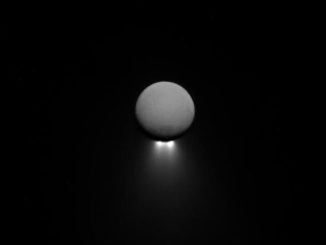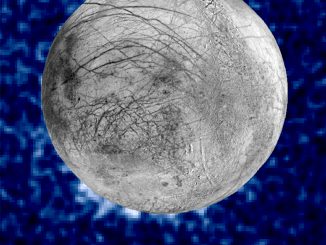
Enceladus


Surprise methanol detection points to evolving story of Enceladus’s plumes
A serendipitous detection of the organic molecule methanol around an intriguing moon of Saturn suggests that material spewed from Enceladus undertakes a complex chemical journey once vented into space. This is the first time that a molecule from Enceladus has been detected with a ground-based telescope.


Saturn probe prepares for dramatic ring-grazing orbits
A thrilling ride is about to begin for NASA’s Cassini spacecraft. Engineers have been pumping up the probe’s orbit around Saturn this year to increase its tilt with respect to the planet’s equator and rings. And on 30 November, following a gravitational nudge from Saturn’s moon Titan, Cassini will enter the first phase of the mission’s dramatic endgame.

Saturn’s moon Dione harbours a subsurface ocean
A subsurface ocean lies deep within Saturn’s moon Dione, according to new data from the Cassini mission. Two other moons of Saturn, Titan and Enceladus, are already known to hide global oceans beneath their icy crusts. Researchers believe that Dione’s crust floats on an ocean several tens of kilometres deep located 100 kilometres below the surface.

Hubble spots possible water plumes erupting on Jupiter’s moon Europa
Astronomers using NASA’s Hubble Space Telescope have imaged what may be water vapour plumes erupting 125 miles (200 kilometres) off the surface of Jupiter’s moon Europa. Europa has a huge global ocean containing twice as much water as Earth’s oceans, but it is protected by a layer of extremely cold and hard ice of unknown thickness.


Saturn’s moon Enceladus and its paper-thin crust
Researchers have used data collected by the Cassini spacecraft to build a computer simulation of Saturn’s icy ocean moon Enceladus that includes the thickness of the ice crust. At its south poles, huge geysers of water jet into space. These come from the ocean depths and suggest that the ice there must be relatively thin for this to happen.

Cassini spacecraft samples interstellar dust near Saturn
NASA’s Cassini spacecraft has been in orbit around Saturn since 2004, studying the giant planet, its rings and its moons. Among the myriad microscopic grains collected by Cassini, a special three dozen stand out from the crowd. Scientists conclude these specks of material came from interstellar space — the space between the stars.

Saturn’s past and present moons
Saturn’s beautiful rings form a striking feature, cutting across this image of two of the planet’s most intriguing moons: Titan (diameter, 3,200 miles) and Enceladus (313 miles). The rings have been a source of mystery since their discovery in 1610 by Galileo Galilei, but there is not full agreement on how they formed.
